Table of Contents
Sharks are often misunderstood creatures, and while some can be intimidating, there are several species known for their relatively friendly behavior towards humans. Here are the Best Top 10 Most Friendly Sharks 2023:
Best Top 10 Most Friendly Sharks 2023
- Whale Shark (Rhincodon typus)
- Nurse Shark (Ginglymostoma cirratum)
- Leopard Shark (Triakis semifasciata)
- Bamboo Shark (Family Hemiscylliidae)
- Zebra Shark (Stegostoma fasciatum)
- Blacktip Reef Shark (Carcharhinus melanopterus)
- Spinner Shark (Carcharhinus brevipinna)
- Gray Reef Shark (Carcharhinus amblyrhynchos)
- Port Jackson Shark (Heterodontus portusjacksoni)
- Wobbegong Shark (Family Orectolobidae)

Join our Telegram Channel for Updates
Best Top 10 Most Friendly Sharks 2023: The Whale Shark [The Gentle Giant of the Ocean (Rhincodon typus)]
![Best Top 10 Most Friendly Sharks 2023: The Gentle Giant of the Ocean (The Whale Shark [Rhincodon typus])](https://jamnet.com.ng/wp-content/uploads/2023/09/whale-shark-physical-appearance-300x200.webp)
![Best Top 10 Most Friendly Sharks 2023: The Gentle Giant of the Ocean (The Whale Shark [Rhincodon typus])](https://jamnet.com.ng/wp-content/uploads/2023/09/whale-shark-physical-appearance-300x200.webp)
Physical Characteristics
The whale’s most distinguishing feature is its sheer size. These colossal fish can reach lengths of up to 40 feet (12 meters) or more and weigh as much as 20.6 metric tons. Their massive bodies are typically grayish-blue with a pattern of white spots and stripes, creating a beautiful mosaic-like appearance on their skin. These patterns are unique to each individual and are often used by researchers for identification.
Diet and Feeding Behavior
![Best Top 10 Most Friendly Sharks 2023: The Gentle Giant of the Ocean (The Whale Shark [Rhincodon typus])](https://jamnet.com.ng/wp-content/uploads/2023/09/Whale-Shark-feeding-300x200.webp)
![Best Top 10 Most Friendly Sharks 2023: The Gentle Giant of the Ocean (The Whale Shark [Rhincodon typus])](https://jamnet.com.ng/wp-content/uploads/2023/09/Whale-Shark-feeding-300x200.webp)
As filter feeders, whales rely on a diet of plankton, small fish, and minute organisms. Despite their gigantic size, they move leisurely through the water with their mouths agape, filtering immense amounts of water to extract their tiny prey. They use specialized filter pads and sieve-like structures in their gills to trap their food, allowing the water to pass harmlessly through their gill slits. Their serene feeding practice makes them completely harmless to humans.
Peaceful Encounters
Rhincodon typus are known for their amicable relationship with humans, which can be attributed to their docile nature. Rhincodon typus are known for their calm and unthreatening demeanor, unlike some other shark species that may display aggression or territorial behavior. They are unhurried swimmers, usually moving at a leisurely pace, which makes them easy targets for divers and snorkelers to approach.
Curiosity and Playfulness
Rhincodon typus has been witnessed exhibiting an inquisitive behavior towards humans without any harmful intentions. In several renowned whale shark watching spots, including the Maldives, the Philippines, and Mexico’s Yucatan Peninsula, divers, and snorkelers have shared their encounters with these magnificent creatures, where they swim close to humans, displaying interest in their presence. While it’s crucial to maintain a respectful distance and not disrupt them, these interactions often leave participants with unforgettable memories of their peaceful interactions with these colossal beings.
Best Top 10 Most Friendly Sharks 2023: The Enigmatic Nurse Shark [(Ginglymostoma cirratum) Gentle Guardian of the Seas]
![Best Top 10 Most Friendly Sharks 2023: The Enigmatic Nurse Shark [(Ginglymostoma cirratum) Gentle Guardian of the Seas]](https://jamnet.com.ng/wp-content/uploads/2023/09/Nurse-Shark-Physical-Appearance-300x199.webp)
![Best Top 10 Most Friendly Sharks 2023: The Enigmatic Nurse Shark [(Ginglymostoma cirratum) Gentle Guardian of the Seas]](https://jamnet.com.ng/wp-content/uploads/2023/09/Nurse-Shark-Physical-Appearance-300x199.webp)
Physical Characteristics:
Nurse sharks have a stout, elongated body with a wide head and tiny eyes. One of their most notable features is the presence of barbels – fleshy, whisker-like projections close to their nostrils. These barbels are incredibly sensitive and assist nurse sharks in detecting prey concealed in crevices and sand. Their skin is mostly brown or gray and is covered in small, rough scales.
The nurse shark is known for its amiable nature and is considered non-confrontational towards humans unless provoked or threatened. These sharks usually spend their days resting on the ocean floor in groups, making them a favorite subject for underwater photographers and divers. Swimmers and snorkelers often encounter nurse sharks without any issues, as these sharks tend to disregard their presence.
Feeding, Reproduction, and Behavior
![Best Top 10 Most Friendly Sharks 2023: The Enigmatic Nurse Shark [(Ginglymostoma cirratum) Gentle Guardian of the Seas]](https://jamnet.com.ng/wp-content/uploads/2023/09/Nurse-Shark-feeding-300x200.webp)
![Best Top 10 Most Friendly Sharks 2023: The Enigmatic Nurse Shark [(Ginglymostoma cirratum) Gentle Guardian of the Seas]](https://jamnet.com.ng/wp-content/uploads/2023/09/Nurse-Shark-feeding-300x200.webp)
Nurse sharks are ovoviviparous, which means their eggs mature and hatch inside the female’s body. After a gestation period of roughly six months, female nurse sharks give birth to live pups, usually delivering 20 to 30 young in a single litter. The pups are self-sufficient at birth and are left to fend for themselves in the ocean.
They are recognized for their tendency to congregate and socialize, often resting near one another during the day. These groups can offer protection from potential predators and provide an excellent opportunity for researchers to investigate their social conduct.
Friendly Encounters
Humans frequently come across nurse sharks when exploring their warm, tropical environments. Divers and snorkelers often find themselves in the company of these mesmerizing creatures, and many have shared heartening accounts of close encounters. Nurse sharks have been observed swimming elegantly alongside humans, seemingly unfazed by their presence. These calm interactions have left an indelible impression on those lucky enough to experience them.
Best Top 10 Most Friendly Sharks 2023: The Graceful Beauty of the Leopard Shark (Triakis semifasciata)
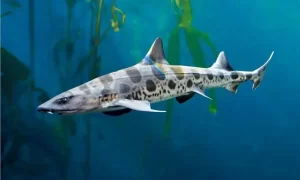

The leopard shark (Triakis semifasciata) is an exceptional species that flourishes along the Pacific coast of North America. Recognized for its remarkable appearance, elegant disposition, and interesting conduct, this shark has endeared itself to marine scientists.
Physical Characteristics
The leopard shark derives its name from its exceptional pattern of dark, leopard-like spots decorating its light-colored body. These spots are especially noticeable along its back, lending it a visually captivating appearance. Adult leopard sharks usually grow to lengths of 3 to 4 feet (about 0.9 to 1.2 meters), making them a relatively small member of the shark family. They have a slim body, a flattened head, and large, expressive eyes.
Leopard sharks are predominantly present across the eastern Pacific Ocean, from southern Oregon to Baja California in Mexico. They inhabit shallow coastal waters, estuaries, and bays, making them a regular sight for divers, snorkelers, and beach enthusiasts. These sharks have a strong liking for sandy and muddy substrates, where they can locate prey and find sanctuary.
Diet, Feeding, and Behavior
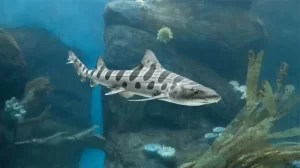

Leopard sharks are opportunistic predators with a diverse diet. They primarily feed on small fish, crustaceans, mollusks, and invertebrates that live on the ocean floor. They use their sensory barbels that are located near their mouths to sense and locate prey concealed in the sediments. Their feeding behavior is marked by systematic and deliberate hunting, highlighting their flexibility in adapting to various prey items.
“Leopard sharks follow an oviparous reproductive strategy where the females lay oblong egg cases known as “mermaid’s purses” that have tendrils to attach to underwater structures. These eggs undergo incubation for several months and eventually hatch, giving birth to miniature versions of adult sharks. It takes several years for leopard sharks to reach maturity, as they grow relatively slowly. However, this slow growth rate makes them vulnerable to overfishing.”
During summer months, Leopard sharks exhibit a social behavior that is highly gregarious and they tend to form large groups. Researchers see this as an opportunity to study their behavior. The exact reasons behind these gatherings are still not fully understood, but they are believed to be linked to mating, foraging, or thermoregulation.
Friendly Encounters
Leopard sharks are known for their friendly interactions with humans. When they encounter divers or snorkelers, they typically display curiosity instead of aggression. Many underwater enthusiasts have shared heartwarming stories of swimming alongside these sharks and experiencing their gentle and inquisitive nature firsthand.
Their relatively small size, which ranges from 3 to 4 feet (about 0.9 to 1.2 meters) in length for adult leopard sharks, makes these interactions possible. They are approachable and lack territorial behavior, making them an attractive subject for underwater photographers and those seeking to connect with the ocean’s wildlife.
Best Top 10 Most Friendly Sharks 2023: The Fascinating Bamboo Shark [(Family Hemiscylliidae) A Study in Ancient Elegance]
![Best Top 10 Most Friendly Sharks 2023: The Fascinating Bamboo Shark [(Family Hemiscylliidae) A Study in Ancient Elegance]](https://jamnet.com.ng/wp-content/uploads/2023/09/bamboo-shark-physical-appearance-300x300.webp)
![Best Top 10 Most Friendly Sharks 2023: The Fascinating Bamboo Shark [(Family Hemiscylliidae) A Study in Ancient Elegance]](https://jamnet.com.ng/wp-content/uploads/2023/09/bamboo-shark-physical-appearance-300x300.webp)
Within the Hemiscylliidae family, there exist several bamboo shark species, each possessing unique characteristics and distribution. The brown-banded bamboo shark (Chiloscyllium punctatum), the white-spotted bamboo shark (Chiloscyllium plagiosum), and the epaulette shark (Hemiscyllium ocellatum) are some of the well-known members of this family. Contrary to the commonly known apex predators like great whites or hammerheads, bamboo sharks are often more closely related to rays despite their taxonomic classification as sharks.
Physical Characteristics:
Bamboo sharks have slender bodies, flattened heads, and long tails, making them well-equipped for maneuvering the ocean floor. They derive their name from the fine, bamboo-like ridges on their dorsal fins and backs. These sharks are usually characterized by modest colors like browns, grays, or tans, offering effective camouflage against the sandy or rocky substrates of their habitats.
They are well-suited for bottom-dwelling existence. Their elongated snouts aid them in searching for small invertebrates, crustaceans, and other prey hidden in the substrate. Their small size, which ranges from about 2 to 4 feet (60 to 120 centimeters), enables them to access tight spaces and forage efficiently.
Bamboo sharks possess an ancient lineage, making them a living fossil group that has been existing for millions of years. Their existence offers valuable insights into the evolutionary history of elasmobranchs. Their unique characteristics and phylogenetic position shed light on the origins and diversification of modern sharks
Reproduction, Behavior, and Nocturnal Habits
![Best Top 10 Most Friendly Sharks 2023: The Fascinating Bamboo Shark [(Family Hemiscylliidae) A Study in Ancient Elegance]](https://jamnet.com.ng/wp-content/uploads/2023/09/Bamboo-shark-feeding-300x225.webp)
![Best Top 10 Most Friendly Sharks 2023: The Fascinating Bamboo Shark [(Family Hemiscylliidae) A Study in Ancient Elegance]](https://jamnet.com.ng/wp-content/uploads/2023/09/Bamboo-shark-feeding-300x225.webp)
They are primarily nocturnal creatures, venturing out at night to hunt and explore. During the day, they seek refuge in coral crevices, caves, or other sheltered areas where they can rest and avoid potential predators. This behavior makes them less commonly seen by divers and snorkelers, adding to their air of mystery.
Friendly Encounters
Bamboo sharks are known for their calm and non-threatening behavior, adding to their endearing qualities. Unlike their larger, more predatory shark counterparts, these sharks are generally gentle and rarely exhibit aggression toward humans. This feature characterized them in the Best Top 10 Most Friendly Sharks 2023. They are not known to pose a danger to divers or snorkelers, even when closely approached.
Best Top 10 Most Friendly Sharks 2023: The Zebra Shark (Stegostoma fasciatum): A Graceful Patterned Wonder of the Ocean
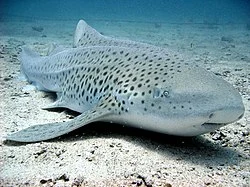

The zebra shark (Stegostoma fasciatum), also known as the spotted carpet shark, is a remarkable and visually captivating species that inhabits the warm waters of the Indo-Pacific region. Renowned for its distinctive appearance, intriguing behaviors, and evolutionary significance, the zebra shark stands as a testament to the enduring elegance of marine life.
Physical Characteristics
The zebra shark’s name is derived from its striking and instantly recognizable appearance. While young zebra sharks are adorned with dark bands and spots resembling a zebra’s stripes, mature individuals transform. As they age, these markings evolve into a more leopard-like pattern of spots, earning them the nickname “leopard shark twin.” This dramatic change in appearance is one of the zebra shark’s distinctive features.
Zebra sharks have a distinctive body shape with a long, cylindrical form and a flattened head. Their bodies are covered in small, rough scales, which contribute to their unique texture. They have a pair of barbels near their nostrils, which they use to locate prey hidden in the sand or among coral crevices. Typically, zebra sharks reach lengths of 5 to 8 feet (1.5 to 2.4 meters), although some individuals can grow even larger.
Reproduction, Behavior, and Nocturnal Habits
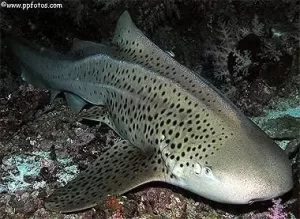

Zebra sharks are found throughout the tropical and subtropical waters of the Indo-Pacific region. They inhabit coral reefs, sandy bottoms, and rocky ledges, making them a common sight for divers and snorkelers in these regions. These sharks are known for their preference for relatively shallow waters, typically ranging from 10 to 60 meters in depth.
They are primarily nocturnal predators, actively foraging for food during the night. Their diet is diverse and includes a variety of bottom-dwelling organisms such as crustaceans, mollusks, small fish, and invertebrates. They use their barbels and specialized teeth to capture and consume their prey, making them well-suited for their benthic lifestyle.
Zebra sharks follow an oviparous reproductive strategy, where females lay eggs that develop outside their bodies. The egg cases, often referred to as “mermaid’s purses,” are rectangular and have long tendrils that anchor them to underwater structures. After a gestation period of several months, the eggs hatch, giving rise to miniature versions of the adult zebra sharks.
Friendly Encounters
One of the most endearing qualities of zebra sharks is their calm and non-threatening behavior. Unlike some other shark species known for their predatory instincts, zebra sharks are known for their peaceful demeanor. This feature characterized them in the Best Top 10 Most Friendly Sharks 2023. They are not known to display aggression towards humans, even when closely approached. This makes them an attractive subject for underwater photographers, divers, and snorkelers.
Best Top 10 Most Friendly Sharks 2023: The Blacktip Reef Shark (Carcharhinus melanopterus): Elegance Beneath the Waves


The blacktip reef shark (Carcharhinus melanopterus) is a captivating and iconic species that grace the warm, shallow waters of the Indo-Pacific region. Renowned for its distinctive appearance, acrobatic displays, and significant role in coral reef ecosystems, the blacktip reef shark stands as the beauty and complexity of marine life.
Physical Characteristics
As the name suggests, the blacktip reef shark is characterized by its striking black-tipped dorsal fin and the edges of its pectoral fins, which contrast beautifully with its bronze-to-grayish-brown body. These dark markings against a lighter background make it an instantly recognizable species. Adults typically measure around 5 to 6.5 feet (1.5 to 2 meters) in length, although larger individuals have been recorded.
Blacktip reef sharks are found in a wide range of habitats, from shallow coral reefs and lagoons to deeper coastal waters, throughout the Indo-Pacific region. Their distribution spans from the eastern coast of Africa to the western coast of the Americas, including the waters around Southeast Asia, Australia, and the islands of the Pacific Ocean. Their preference for warm, coastal habitats makes them a common sight for divers and snorkelers in these regions.
Reproduction, Behavior, and Nocturnal Habits


Blacktip reef sharks are opportunistic predators with a diverse diet. They primarily prey on small fish, crustaceans, and cephalopods found within their coral reef habitats. Their hunting strategy typically involves patrolling the reefs and using bursts of speed to chase down prey. The blacktip reef shark’s keen senses and agility make it a formidable predator in these complex underwater environments.
Blacktip reef sharks exhibit viviparity, a reproductive strategy in which females give birth to live, fully developed pups rather than laying eggs. After a gestation period of around 10 to 12 months, females give birth to a litter of 2 to 5 pups. The newborns are approximately 1 to 2 feet (30 to 60 centimeters) in length and are immediately independent.
Blacktip reef sharks are known to be social animals, often found in small groups or schools. These gatherings may consist of individuals of various ages and sizes, which adds to the allure of encountering these sharks in their natural environment. Observing their interactions within the school can be a rewarding experience for those fortunate enough to witness it.
Friendly Encounters
Blacktip reef sharks often exhibit cautious curiosity when encountering humans in their natural habitat. They may approach divers and snorkelers to investigate their presence but typically maintain a respectful and non-confrontational distance. This feature characterized them in the Best Top 10 Most Friendly Sharks 2023. This inquisitive behavior provides underwater enthusiasts with the opportunity to observe these magnificent creatures up close while respecting their boundaries.
One of the most captivating aspects of the blacktip reef shark is its acrobatic displays. These sharks are known for their aerial leaps and graceful swimming patterns, often breaching the water’s surface in an exuberant display of athleticism. Such behavior is believed to serve various purposes, including communication, predator avoidance, and potentially even as a hunting technique.
Best Top 10 Most Friendly Sharks 2023: The Spinner Shark (Carcharhinus brevipinna [The Aerial Acrobat of the Ocean])
![Best Top 10 Most Friendly Sharks 2023: The Spinner Shark (Carcharhinus brevipinna [The Aerial Acrobat of the Ocean])](https://jamnet.com.ng/wp-content/uploads/2023/09/spinner-shark-physical-appearance-300x159.webp)
![Best Top 10 Most Friendly Sharks 2023: The Spinner Shark (Carcharhinus brevipinna [The Aerial Acrobat of the Ocean])](https://jamnet.com.ng/wp-content/uploads/2023/09/spinner-shark-physical-appearance-300x159.webp)
Physical Characteristics
The spinner shark is characterized by its sleek, streamlined body, typically bronze or grayish, with a white belly. Its name is derived from the acrobatic displays it performs, which involve spinning or leaping out of the water. These sharks have a long, pointed snout and relatively large eyes, which aid in their hunting abilities. Adult spinner sharks typically measure between 6 and 9 feet (1.8 to 2.7 meters) in length.
Reproduction, Behavior, and Nocturnal Habits
![Best Top 10 Most Friendly Sharks 2023: The Spinner Shark (Carcharhinus brevipinna [The Aerial Acrobat of the Ocean])](https://jamnet.com.ng/wp-content/uploads/2023/09/spinner-shark-feeding-300x181.webp)
![Best Top 10 Most Friendly Sharks 2023: The Spinner Shark (Carcharhinus brevipinna [The Aerial Acrobat of the Ocean])](https://jamnet.com.ng/wp-content/uploads/2023/09/spinner-shark-feeding-300x181.webp)
Spinner sharks are carnivorous predators with a diverse diet that includes small fish, squid, and various pelagic species. Their hunting strategy involves joining schools of prey fish, swimming at high speeds, and using their spinning leaps to confuse and scatter the prey, making it easier to catch individual fish. Their streamlined bodies and agility make them formidable hunters in open water.
Spinner sharks exhibit viviparity, a reproductive strategy in which females give birth to live, fully-developed pups rather than laying eggs. After a gestation period of about 10 to 12 months, females give birth to a litter of typically 3 to 15 pups. These newborns are approximately 2 feet (60 centimeters) in length and are immediately independent. Spinner sharks have a relatively fast growth rate compared to some other shark species.
Friendly Encounters
Despite their formidable appearance and hunting abilities, spinner sharks are not known for aggression towards humans. This feature characterized them in the Best Top 10 Most Friendly Sharks 2023. They tend to be curious and may approach divers and snorkelers. While these sharks are not typically considered a threat, it is essential to approach them with caution and respect their space in their natural habitat.
Best Top 10 Most Friendly Sharks 2023: The Gray Reef Shark (Carcharhinus amblyrhynchos [Guardian of the Coral Reefs])
![Best Top 10 Most Friendly Sharks 2023: The Gray Reef Shark (Carcharhinus amblyrhynchos [Guardian of the Coral Reefs])](https://jamnet.com.ng/wp-content/uploads/2023/09/gray-reef-physical-appearance-300x225.webp)
![Best Top 10 Most Friendly Sharks 2023: The Gray Reef Shark (Carcharhinus amblyrhynchos [Guardian of the Coral Reefs])](https://jamnet.com.ng/wp-content/uploads/2023/09/gray-reef-physical-appearance-300x225.webp)
Physical Characteristics
The gray reef shark is named for its grayish coloration and the distinctive white patch located just above its pectoral fins. This species typically grows to lengths of 6 to 8 feet (1.8 to 2.4 meters), with females often being slightly larger than males. Their streamlined bodies, elongated snouts, and keen eyesight make them well-suited for life in coral reef environments.
Reproduction, Behavior, and Nocturnal Habits
![Best Top 10 Most Friendly Sharks 2023: The Gray Reef Shark (Carcharhinus amblyrhynchos [Guardian of the Coral Reefs])](https://jamnet.com.ng/wp-content/uploads/2023/09/gray-reef-feeding-300x209.webp)
![Best Top 10 Most Friendly Sharks 2023: The Gray Reef Shark (Carcharhinus amblyrhynchos [Guardian of the Coral Reefs])](https://jamnet.com.ng/wp-content/uploads/2023/09/gray-reef-feeding-300x209.webp)
Gray reef sharks are known for their social nature and are often observed in small groups or schools. These groups may consist of individuals of various ages and sizes, with older and larger individuals often taking on leadership roles. Their social structure is believed to provide various advantages, including cooperative hunting and increased protection from potential threats.
As opportunistic predators, gray reef sharks have a diverse diet that includes a variety of prey species found within their coral reef habitats. They primarily feed on small fish, cephalopods, and crustaceans. Their hunting strategy typically involves patrolling the reefs and using bursts of speed to capture prey. Gray reef sharks are known for their role in controlling the populations of certain prey species, helping to maintain the overall balance of coral reef ecosystems.
Gray reef sharks follow a viviparous reproductive strategy, where females give birth to live, fully developed pups rather than laying eggs. After a gestation period of approximately 10 to 12 months, females give birth to a litter of typically 1 to 6 pups. The pups are about 1.5 feet (0.45 meters) in length at birth and are immediately independent, venturing out into the coral reef environment.
Friendly Encounters
Gray reef sharks are known for their generally respectful and non-aggressive behavior towards humans. This feature characterized them in the Best Top 10 Most Friendly Sharks 2023. When encountered by divers and snorkelers, they often maintain a safe distance and are more likely to avoid human interaction rather than approach aggressively. While they may exhibit curiosity, they rarely pose a threat to humans when left undisturbed.
Best Top 10 Most Friendly Sharks 2023: The Port Jackson Shark (Heterodontus portusjacksoni [A Unique Marvel of the Southern Seas])
![Best Top 10 Most Friendly Sharks 2023: The Port Jackson Shark (Heterodontus portusjacksoni [A Unique Marvel of the Southern Seas])](https://jamnet.com.ng/wp-content/uploads/2023/09/port-Jackson-shark-physical-appearance-300x225.webp)
![Best Top 10 Most Friendly Sharks 2023: The Port Jackson Shark (Heterodontus portusjacksoni [A Unique Marvel of the Southern Seas])](https://jamnet.com.ng/wp-content/uploads/2023/09/port-Jackson-shark-physical-appearance-300x225.webp)
Physical Characteristics
The Port Jackson shark boasts an appearance that sets it apart from many other shark species. Its body is robust and cylindrical, with a mottled, brownish-gray coloration and striking patterns of lighter spots. However, what truly makes the Port Jackson shark stand out are its stout, toothy jaws and the horn-like projections on its head. These features give it an endearing and somewhat comical appearance.
Port Jackson sharks are primarily found in the coastal waters of southern Australia, from Queensland to New South Wales, and across to the waters of South Australia and Tasmania. They inhabit a range of environments, from rocky reefs and kelp forests to sandy bottoms, often found at depths of 10 to 100 meters. Their preference for these diverse habitats makes them a vital component of southern Australian marine ecosystems.
Reproduction, Behavior, and Nocturnal Habits
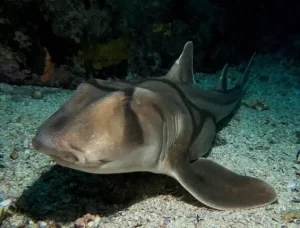

Port Jackson sharks have a fascinating reproductive strategy known as oviparity. Females lay large, spiral-shaped egg cases, commonly referred to as “mermaid’s purses,” in rocky crevices or on the ocean floor. These egg cases protect the developing embryos, which receive nourishment from a yolk sac. After an incubation period of several months, the eggs hatch, giving rise to miniature versions of the adult sharks. This unique reproductive process is a key part of the Port Jackson shark’s life cycle.
Friendly Encounters
Port Jackson sharks are known for their generally non-aggressive and peaceful demeanor when encountered by humans. This feature characterized them in the Best Top 10 Most Friendly Sharks 2023. Divers and snorkelers often report close encounters with these sharks, describing them as inquisitive but non-threatening. They tend to maintain a safe and respectful distance when approached, allowing observers to appreciate their unique beauty without causing distress to the sharks.
Best Top 10 Most Friendly Sharks 2023: The Wobbegong Shark (Family Orectolobidae [A Master of Camouflage])
![Best Top 10 Most Friendly Sharks 2023: The Wobbegong Shark (Family Orectolobidae [A Master of Camouflage])](https://jamnet.com.ng/wp-content/uploads/2023/09/wobbegong-shark-physical-appearance-300x159.webp)
![Best Top 10 Most Friendly Sharks 2023: The Wobbegong Shark (Family Orectolobidae [A Master of Camouflage])](https://jamnet.com.ng/wp-content/uploads/2023/09/wobbegong-shark-physical-appearance-300x159.webp)
Physical Characteristics
Wobbegong sharks are often referred to as “carpet sharks” due to their remarkable camouflage capabilities. Their body is adorned with an intricate pattern of mottled colors and textures, which closely resembles the seafloor and surrounding coral reef. This camouflaging adaptation allows them to blend seamlessly into their environment, making them nearly invisible to both prey and predators.
The wobbegong shark’s appearance is truly unique and unforgettable. Their flattened bodies are elongated, with broad, paddle-shaped fins and a wide, fleshy head. Their most distinctive feature is the fringe of dermal lobes or “beards” that surround their mouths, which resemble a tasseled, shaggy carpet. These lobes play a crucial role in concealing the shark as it lies in ambush.
Reproduction, Behavior, and Nocturnal Habits
![Best Top 10 Most Friendly Sharks 2023: The Wobbegong Shark (Family Orectolobidae [A Master of Camouflage])](https://jamnet.com.ng/wp-content/uploads/2023/09/wobbegong-shark-feeding-300x200.webp)
![Best Top 10 Most Friendly Sharks 2023: The Wobbegong Shark (Family Orectolobidae [A Master of Camouflage])](https://jamnet.com.ng/wp-content/uploads/2023/09/wobbegong-shark-feeding-300x200.webp)
Wobbegong sharks are ovoviviparous, meaning that the females give birth to live young. After an internal gestation period, females can give birth to a litter of up to 37 pups, each enclosed in a thin, transparent egg case. The pups are fully independent upon birth, and they quickly adapt to their camouflaging skills to survive in their complex underwater world.
Friendly Encounters
Wobbegong sharks are typically gentle and non-aggressive when encountered by humans. This feature characterized them in the Best Top 10 Most Friendly Sharks 2023. Divers and snorkelers often describe their encounters as serene. These sharks tend to remain motionless on the seafloor, relying on their camouflage to evade detection. While they may display curiosity, they seldom pose a threat to humans and prefer to avoid interaction when approached.









